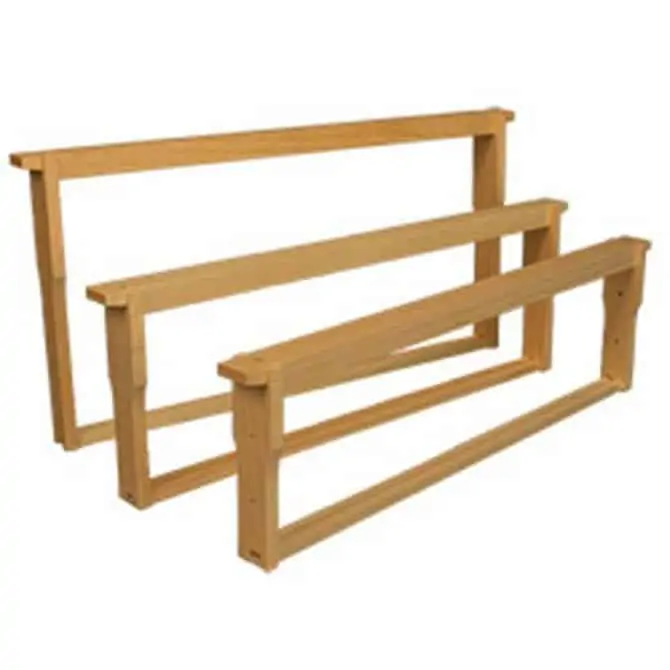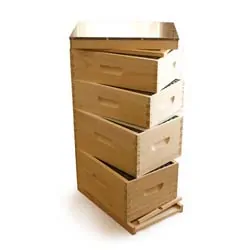(This article is a companion to the PerfectBee Guide to Langstroth Hives, which you can read here).
The Langstroth is the workhorse of beehives. It is, by some distance, the most common beehive in the US and in many other parts of the world. The Langstroth design springs from the 1800’s and hasn’t changed a great deal in that time.

The focal point of the Langstroth are the boxes in which your bees will live. This Buyers Guide looks at the options available when purchasing boxes for your Langstroth beehive.
To browse the full range of boxes at the PerfectBee Store see here.
Langstroth Components
Let’s recap how boxes fit into the overall design of the Langstroth hive. There are several components to the Langstroth, but the basic structure includes a bottom board, one or more boxes – the focus of this Buyers Guide – an inner cover and a top cover.
A number of other accessories are available, such as feeders, entrance reducers, slatted racks and more. But the most simple Langstroth configuration is, by design, simple and effective.
So, let’s look at the boxes used with a Langstroth hive in more detail.
How Bees Use Boxes
Let’s start with the bees. Why is a box important to your bees and how do they use it?
Well, the obvious response is that boxes in a Langstroth hive are, of course, where your bees build their home. Boxes form the focal point of the entire colony, with other components primarily there to protect and provide access to the boxes.
The boxes provide shelter and a place for bees to build comb, on which they raise brood and store resources such as honey and pollen.
Frames

Within each box we hang frames. Traditionally in a Langstroth these include foundation (see below), but that is not a requirement. A significant number of beekeepers practice natural beekeeping and, in that scenario, foundationless frames are quite popular.
The standardized sizes of the Langstroth box, covered below, mean that frames are also standardized and can be purchased from many sources. The frame forms a rectangular shape with the top bar being a consistent size. The depth of the frame will depend on the depth of the box in which it is placed.
Foundation
Most Langstroth beekeepers use frames with foundation. There are many options here, including plastic, beeswax-covered plastic and more.
Box Choices
A primary benefit of the Langstroth is the use of standardized dimensions. Boxes can be sourced from any supplier (though we hope, of course, you will consider the PerfectBee Beekeeping Store!) and you can be assured they will fit, assuming you are consistent in depth.
The length of each box is consistent at 19 7/8″, leaving two dimensions you need to consider when purchasing boxes for your Langstroth.
- Depth: This dictates the depth of the frames accommodated – deep, medium or shallow.
- Width: This dictates how many frames are accommodated – 8 or 10 frames*.
* Nucs typically support 5 frames.
Depth
Langstroth boxes come in three choices of depth, as follows (we look at how you decide which depth to choose later in this Buyers Guide).
- Deep: The deep box supports frames with a depth of 9 5/8” (deep frames). Deep boxes are often used as the brood box at the bottom of Langstroth. That said, the beekeeper happy to life heavy weights might also consider them as honey supers! They can also be used as a honey box.
- Medium: Medium boxes supports frames with a depth of 6 5/8” (medium frames). Medium boxes are also commonly for brood but are also an excellent choice for honey supers
- Shallow: The shallow box supports frames with a depth of 5 3/4“. Shallow boxes are used for honey supers.
Number of Frames
The other important choice for boxes is the number of frames accepted. The two options are 8 or 10 frames.
There are no functional differences between these, beyond a honey-filled 8 frame box being considerably lighter than a 10 frame box.
Choices of Wood
There are a number of choice available for boxes, but the most common is pine. Like the Langstroth itself, pine is a workhorse of woods! It has been used for decades by beekeepers and, with a coat of paint, is an excellent choice.
Cedar is also used by many beekeepers and has a number of advantages over pine. These include being lighter, having better longevity and – subjectively – is a more attractive wood.
The aesthetic quality of cedar is emphasized by the fact that it need not be painted. Many beekeepers apply a coat of tung oil, which doesn’t just leave the beautiful wood visible but actually enhances its deep color.
Painted / Unpainted
Relevant primarily to pine boxes (cedar boxes do not need to be painted), boxes are sometimes available painted or unpainted. This is simply a choice of convenience on receipt of the box and whether the beekeeper will to paint the boxes.
The majority of beekeepers paint their pine boxes.
Assembled vs. Kit
Many beekeepers like to purchase assembled boxes, to save time on receipt. However, a few dollars can sometimes be saved if box kits, needing assembly by the beekeeper, are used.
Deciding On Your Boxes
So, where does this leave you in terms of deciding which box to purchase? Use the following factors to make your decision.
Ease of Setup
Some beekeepers prefer to order an assembled box, to save some time. That said, the box is a simple design and knocking a few nails in shouldn’t take too long.
The choice of wood may have a little more impact on setup time. Pine boxes will need to be painted, which takes time both in application of paint, as well as drying time. By comparison, Cedar boxes don’t need to be painted and are therefore ready-to-go (although many beekeepers like to apply a quick coat of Tung Oil, which drys very quickly).
Weight and Ease of Use
If you find lifting weights a little more challenging – or simply prefer not to do so! – there are a few choices available to you to lighten the load.
First, cedar boxes are lighter than pine. Secondly, many beekeepers prefer to use medium boxes, instead of deep (and maybe shallow for honey supers). Finally, using 8 frames boxes, instead of 10, saves weight.
In summary, the beekeeper looking to reduce the weights to be lifted, would be well served by 8 frame medium boxes made with cedar.
A secondary consideration is the use of boxes with windows. Again, there is no functional difference between boxes with windows and those without. But for a quick look at your bees, windows can be a lot of fun! Many beekeepers like to use a box with windows in the lower boxes, such as the brood box.
Honey Yield
This is a simple choice of capacity. To maximum the potential honey yield from your honey supers, you might consider deep, 10 frame boxes.
This is not an all-or-nothing-choice, though. Many beekeepers find a medium 10 frame box to be a nice balance.
Longevity
Painted, pine boxes are the traditional choice for Langstroth boxes and should last several years. However, they are a little more vulnerable to wear-and-tear and many beekeepers like the extra longevity of a cedar box, coated with Tung Oil.
Cost
Each of these choices can have an impact on price. Putting things in simple terms, the most expensive box is likely to be:
- Deep
- 10 Frame
- Painted
- Cedar
- Windows
- Assembled
At the other end of the spectrum is:
- Shallow (note: this is only a good choice for honey supers)
- 8 Frame
- Unpainted
- Pine
- No windows
- Unassembled
Another opportunity to save a few dollars is buying boxes that come with frames.

